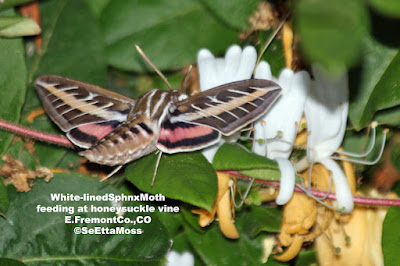Sphinx moth

One of the coolest moths I have seen is the sphinx moth (actually there are a number of really interesting moths). I found this one working a large Japanese honeysuckle vine (a commonly planted non-native plant that in some locations can be invasive in natural areas) on my friend's, but I have also had them in my backyard in Canon City in the past. This is a White-lined Sphinx moth (likely due to the white lines on it's wings) but is often called a hummingbird moth because it hovers over flowers like hummingbirds do. It is also referred to as the Hawk Moth. Though many moths are most active at night, this one is active in both day and night. The bottom pic isn't that good but it does show the probiscus, the feeding tube that extends from it's mouth to flowers to suck up their nectar. SeEtta

